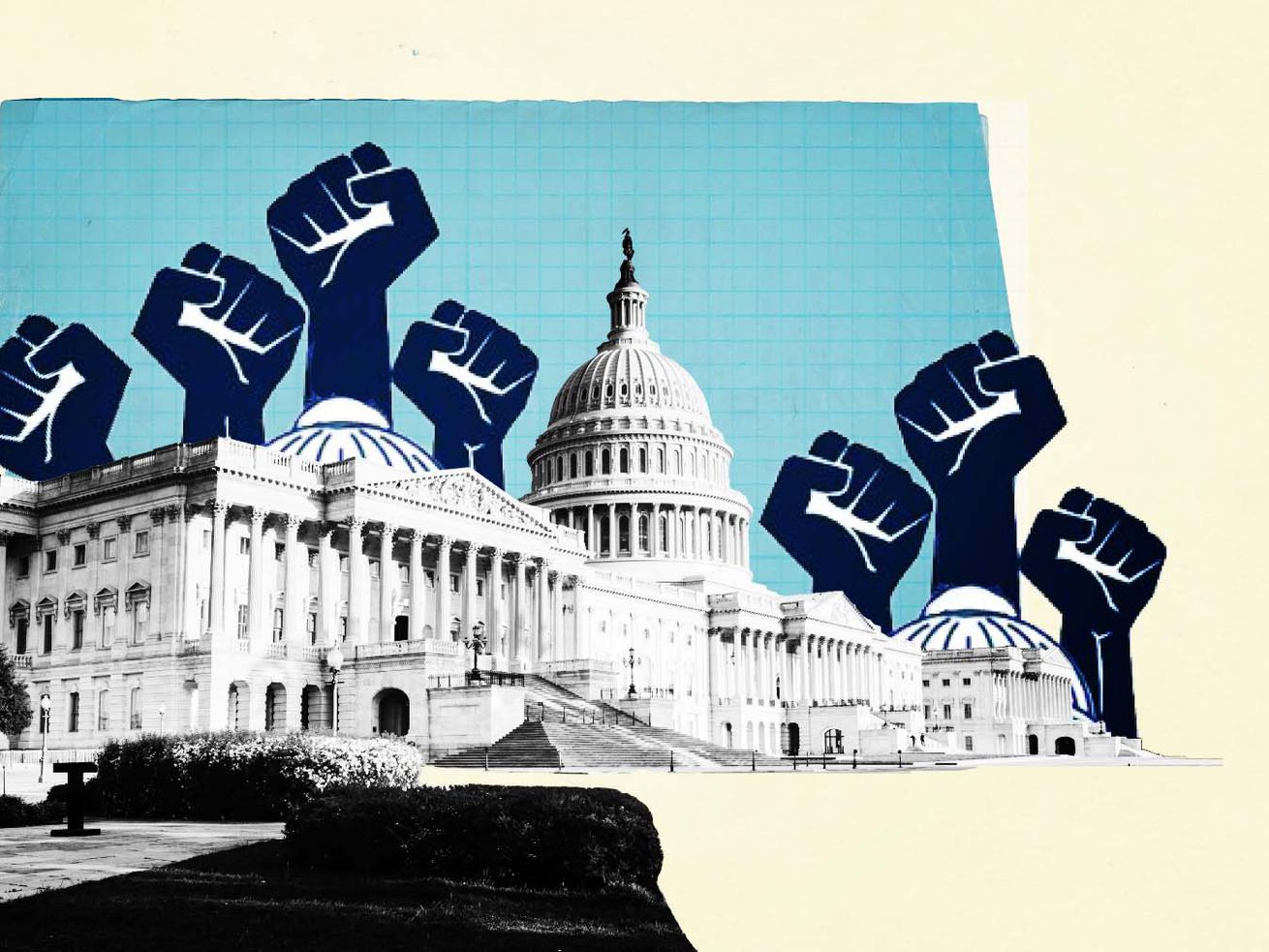The fight for a union in Congress, explained.
House Democrats are facing a telling question: How committed are they to unions when it’s their own employees who want one?
At the moment, there’s no clear answer. In February, top Democrats — including House Speaker Nancy Pelosi and House Majority Leader Steny Hoyer — declared their full-throated support for a unionization effort among congressional staffers. Two months later, however, a resolution that would authorize the effort is stalled.
Two Democratic aides, who declined to comment on the record because the process is ongoing, have cited a procedural glitch for the hold-up, but the union’s organizers, who are eager to make progress before the midterm elections, are losing patience with the delays.
“All of leadership, at this point, has expressed support, has paid lip service,” said an organizer with the Congressional Workers Union (CWU), who spoke anonymously due to concerns about retaliation. “And then they haven’t brought it to the floor.”
The CWU, a group of staffers that launched a union drive earlier this year, wants the House to vote on a resolution guaranteeing staffers protections as soon as next week. Currently, the Congressional Accountability Act allows staffers to organize, but doesn’t offer them any shield from retaliation, meaning staffers could be fired and blacklisted if they do so. Thus far, Pelosi’s office has not commented on when a floor vote could be scheduled on the resolution.
Democrats’ majority in the House means the prospects for passing a resolution there are much higher than in the Senate, where it would require 60 votes — and the backing of at least 10 Republicans. Because of how the Congressional Accountability Act works, each chamber is also able to act independently: A successful resolution in the House would allow offices to unionize there even if the Senate can’t.
The push to unionize congressional staff has gained serious momentum in the last year as staffers have reeled from the January 6 insurrection and the pandemic. Amid these stressors, organizers hope a union could offer some recourse on longstanding issues including low wages, unpredictable hours, and abusive management.
If established, a union could provide staffers significantly more protections than they have now, enabling them to negotiate on a range of subjects, such as pay floors and paid leave.
Union organizers argue Democrats need to be consistent in their support for organized labor. They note that almost every House Democrat voted in favor of the PRO Act, which protects workers’ rights to organize, while more than 50 Democrats have yet to sign on to a unionizing resolution from Rep. Andy Levin (D-MI).
“If Congressional Democrats are For the People,” CWU wrote in a recent letter to House leaders. “We are people too.”
Where the unionizing push in Congress stands
“Like all Americans, our tireless Congressional staff have the right to organize their workplace and join together in a union. If and when staffers choose to exercise that right, they would have Speaker Pelosi’s full support,” Pelosi spokesperson Drew Hammill said on Twitter in February.
Since then, CWU — started by a group of Democratic staffers last year — says it has fielded hundreds of inquiries from staffers expressing interest in unionizing, and urged House leaders to move quickly. Sen. Sherrod Brown (D-OH) is expected to introduce a resolution similar to Levin’s in the Senate, though Democrats’ slim majority there and general GOP opposition to unionization make that more of a longshot.
In early March, the House Administration Committee held a hearing on what unionizing could look like and discussed Levin’s resolution. To move forward, Levin needs to make a technical fix to the measure, the two Democratic aides noted.
Levin says he’s committed to addressing any necessary changes and is working with leadership to “push the resolution through the House process.”
“As is typical, some language may be adjusted, in this case to conform with what the Office of Congressional Workplace Rights [OCWR] is advising the House Committee on Administration,” he told Vox in a statement. Previously, John Uelmen, the general counsel for OCWR, testified that the language in the resolution should follow the wording laid out in the Congressional Accountability Act, and may need to be updated if it doesn’t.
“[It] would purely be a technical change but the substance of the resolution would remain the same,” says OCWR spokesperson Nancy Baldino.
Organizers see this as a simple fix and far from one that should delay a vote.
“It is like the world’s easiest fix. You can fix it before the bill goes to the floor, or you can fix it in a manager’s amendment,” the CWU organizer told Vox. “There’s nothing else [stopping it], leadership can bring it to the floor right now.”
Pelosi’s office did not comment about whether it would support making the change via an amendment.
Organizers are hoping to move quickly on the resolution ahead of this fall’s elections, when Democrats could lose control of the House, in which case any hopes of approving the measure are likely dead. The sooner they’re able to pass it, too, the sooner that different offices can begin to unionize — and negotiate on salary, overtime, and more.
Why staffers want a union
Congressional staffers have dealt with poor working conditions for years.
Currently, one in eight congressional staffers, or nearly 1,200 people, don’t make a living wage for Washington, DC, according to data from LegiStorm analyzed by the nonprofit Issue One. This analysis found that the median salary for staff assistants, an entry-level role on Capitol Hill, was just under $39,000, falling short of the more than $42,000 the Massachusetts Institute of Technology calculated as a living wage for DC residents without children.
“It was just an impossible wage to live on,” a second CWU organizer, whose starting salary was $30,000, told Vox. “I worked Friday night shifts, and Saturday and Sunday brunch at a restaurant … I was working seven days a week.”
The idea that some staffers have to have multiple jobs is relatively normalized on the Hill, aides say, noting that it’s common for people to work as bartenders, Uber drivers, and dog walkers on top of already-demanding roles.
“At the same time … we’re advancing policies to ensure every worker is paid a livable wage …many of us and our colleagues are living on food stamps, are making far less than a livable wage,” a third CWU organizer told Vox.
There are also significant racial and gender disparities across both chambers. There’s an 11-12 percent average pay gap between men and women in both the House and the Senate, according to a 2019 study. Per a 2020 LegiStorm review, there’s a 9.2 percent average pay gap between white and Black staffers as well. And in senior roles on the Hill such as chiefs of staff, policy chiefs, and communications directors, both women and people of color are vastly underrepresented.
“While it may be unintentional, the lack of diversity among staff in senior positions is essentially shutting out millions of Americans with distinct preferences and experiences from the policymaking process,” Dr. LaShonda Brenson, a senior researcher at the Joint Center for Political and Economic Studies, said at a 2021 panel.
An Instagram account called Dear White Staffers, dedicated to capturing the experiences of staffers of color, further underscored many of these issues when it went viral earlier this year. The account, which was established by an anonymous individual, has highlighted submissions from other unnamed staffers about things like verbal abuse, bullying, and racism.
“[The communications director] made fun of my accent. I am Latina. Verbal abuse was rampant,” one submission noted. “I lasted less than a year because I was so stressed that I developed ulcers, my hair fell out, and I broke out into hives,” said another. (Because these submissions are anonymous, Vox has not independently verified them.)
Staffers also have to navigate unpredictable hours that can often include nights and weekends, with no overtime compensation. They have limited avenues to report these issues, and must weigh doing so against potential backlash.
“If you do speak up, your career is ruined,” a current House staffer, who spoke anonymously due to concerns about retaliation, told Vox.
Because of these conditions, many people may forgo jobs on the Hill altogether, while others stay for a short period of time and leave to pursue more lucrative gigs elsewhere. The result is a constant brain drain from Congress and a grueling day-to-day experience for current staffers. The pandemic exacerbated the trend: In 2021, the House saw its highest turnover rate in two decades, with 55 percent more House staffers leaving their roles that year than the previous year.
What a union could do
There’s a lot that staffers would be able to bargain on, says labor expert Kevin Mulshine, who previously served as senior counsel at Congress’s Office of Compliance. Things like salary, remote work, and paid leave are all fair game, he notes.
Unionized staffers could push for higher salary floors, for example, and urge management to set pay bands for different roles, so it’s clear what the salary range should be in those jobs. Currently, pay varies notably by office. For example, Rep. Alexandria Ocasio-Cortez (D-NY) has guaranteed that staffers in her office would make a “living wage,” setting the salary floor in her office at $52,000.
Some staffers hoped for raises after the House approved a 21 percent increase to the Member Representational Allowance, also known as the MRA, which is intended to increase office budgets for staff salaries this year. Because offices operate off of tight allowances, they theoretically have less flexibility for salary negotiations compared to a private sector workplace, so any increase to the MRA is significant.
The MRA updates, however, have only exacerbated existing frustrations. Certain offices haven’t moved quickly to explain when staffers would begin receiving wage increases — or to say if raises were coming at all.
“It’s really brought morale down. You finally get the money and it’s just excuses,” the House staffer said.
Offices also have significant discretion over things like remote work, anti-discrimination policies, and how much leave people are able to take, which employees could bargain on, too.
“You could negotiate over telework, office safety policies. You could negotiate over vacation time. You could negotiate over benefits,” says Daniel Schuman, a policy director for Demand Progress, a progressive advocacy group that supports staffers’ unionizing efforts.
Unlike other workplaces, there are certain constraints that congressional offices face when it comes to what the union can broach, however.
Because of management rights enshrined in the Congressional Accountability Act, a union wouldn’t be able to negotiate on whether someone could be hired or fired. The law also bars staffers from staging a strike or walkout as well.
How unionizing in Congress would work
“An office could voluntarily recognize a union now, but staffers are in a precarious position,” says Schuman.
Levin’s resolution is meant to guarantee the protections they need to move forward. It has 165 Democratic co-sponsors, but would need 217 votes total in order to advance. It’s unclear whether the 50 or so Democrats who have yet to sign on would be willing to support it.
“Many members vote for bills they don’t co-sponsor,” Levin told Vox. “It’s not like I’m asking people to co-sponsor and they’re refusing.”
Because Congress is effectively hundreds of self-contained workplaces, unionizing would happen at the office and committee level, with each office acting as its own bargaining unit. On a committee, the majority’s staff would be its own unit, for example, while the minority’s staff would be its own unit.
It’s also possible that different offices could eventually establish joint priorities, and pool their resources. Congressional offices could work as a collective to hire an advocate for annual budget negotiations, for example.
After the House passes a resolution, staffers may begin organizing 60 days after the required regulations are put in place. If 30 percent of an office was interested in unionizing, they’d be able to file a petition with the Office of Congressional Workplace Rights to do so. The OCWR would then oversee an election in that office, which would require the majority of people eligible for the bargaining unit to vote in favor of unionizing. Once they did, OCWR would recognize the union and the unit could begin trying to iron out a contract with management.
Any protections agreed upon in a contract could stay in place as long as a lawmaker is re-elected.
Were Democrats to approve the resolution while they still have the majority, it would be very difficult for Republicans to roll back these protections, says Mulshine. In order to undo them, Republicans would have to repeal the part of the Congressional Accountability Act which establishes staffers’ right to unionize.
Republicans — none of whom have signed onto Levin’s resolution — have raised a few points against a potential union.
In the March hearing, Republicans’ witness Mark Strand claimed unions could pose a conflict of interest when staffers disagreed with a member on an issue, such as firing a staffer who had poor performance. (The right to layoff employees, however, is guaranteed to managers by the CAA.)
Both Democrats and Republicans have also had questions about the complexities of unionizing since each office operates independently, has different staffing and scheduling needs, and requires flexibility to meet those demands. As Politico previously reported, there’s been uncertainty about whether senior staffers could qualify for a union, and how long it could take offices to ratify a contract.
Experts note that many complicated workplaces have been able to proceed with unionizing — and that some of these issues might not be worked out until negotiations start happening. The Democratic Congressional Campaign Committee is among the recent institutions to unionize, as are individual Starbucks franchises, which have had to organize one by one.
A union could transform Capitol Hill as a workplace
Union organizers hope such protections would fundamentally change the experience of working on the Hill, keeping people from jumping to more lucrative opportunities in the private sector and strengthening the expertise within the institution.
A 2020 report from New America found that 65 percent of staffers weren’t interested in staying on the Hill for more than five years, and that many who plan to leave were eyeing higher-paying lobbying gigs after their departure.
“You need strong, capable congressional staff who are experts in their fields, who can build out their knowledge. What you don’t want is people who are looking to leave after 18 months and go work somewhere else,” says Schuman.
The loss of policy expertise on the Hill has meant that lawmakers are more reliant on lobbyists, who have their own interests in mind when crafting legislation.
Higher salaries would also enable more people to consider roles at the Capitol, since many aren’t currently able to do so.
“The most important part of collectively bargaining is improving wages, improving work conditions, so that people who don’t come from the most privileged backgrounds are able to succeed here,” the first CWU organizer said.
Perhaps most notably, a union would better balance protections for staff against members of Congress, who have few checks on how their offices are run. It wasn’t until 2018 that lawmakers even passed legislation that would hold members personally financially liable for settlements related to sexual misconduct cases, for instance.
“This would drastically change the structure and the culture of the Hill,” the second CWU organizer told Vox. “This would drastically shift how things can operate and how people can be treated.”
Author: Li Zhou
Read More



